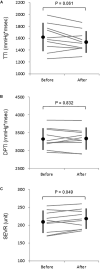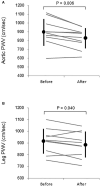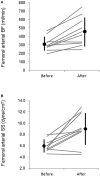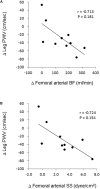Acute Effects of Short-Term Warm Water Immersion on Arterial Stiffness and Central Hemodynamics
- PMID: 33613310
- PMCID: PMC7890244
- DOI: 10.3389/fphys.2021.620201
Acute Effects of Short-Term Warm Water Immersion on Arterial Stiffness and Central Hemodynamics
Abstract
Warm water immersion (WWI) has a potentially favorable effect on vascular health. However, the effects of short-term WWI on vascular function and central hemodynamics remain unclear. The present study aimed to determine the acute effects of short-term WWI on arterial stiffness and central hemodynamics in healthy men. Ten healthy men (27-57 years, 44 ± 12 years of mean age) underwent 5-min WWI (40-41°C) at the heart level. Systemic hemodynamics and tympanic temperature were monitored during WWI. Furthermore, pulse wave velocity (PWV) and aortic hemodynamics were measured before and 10 min after WWI. Cardiac output (CO) (via the Modelflow method) increased (P = 0.037), whereas tympanic temperature did not change (P = 0.879) during WWI. After 5-min WWI, heart rate (HR) and brachial diastolic blood pressure (BP) were significantly decreased. Aortic and leg PWV were decreased by 7.5 and 3.1%, respectively (P = 0.006 and P = 0.040). Femoral arterial blood flow was increased by 45.9% (P = 0.002), and leg vascular resistance was decreased by 29.1% (P < 0.001). Regarding central hemodynamic variables (estimated by general transfer function), aortic BP and augmentation index (AIx) did not change significantly, but the subendocardial viability ratio (SEVR), an index of coronary perfusion, was increased (P = 0.049). Our results indicate that a short-term WWI acutely improves aortic and peripheral arterial stiffness and coronary perfusion. Further studies to determine the interaction between the residual effect of a single bout of short-term WWI and chronic change (e.g., adaptation) in arterial stiffness and central hemodynamics are needed.
Keywords: aortic hemodynamics; arterial stiffness; femoral arterial blood flow; pulse wave analysis; warm water immersion.
Copyright © 2021 Sugawara and Tomoto.
Conflict of interest statement
The authors declare that the research was conducted in the absence of any commercial or financial relationships that could be construed as a potential conflict of interest.
Figures





Similar articles
-
Effects of short-term warm water immersion on cardiac baroreflex sensitivity in healthy men.J Physiol Sci. 2020 Jul 9;70(1):34. doi: 10.1186/s12576-020-00762-1. J Physiol Sci. 2020. PMID: 32646375 Free PMC article.
-
Aortic Hemodynamics and Arterial Stiffness Responses to Muscle Metaboreflex Activation With Concurrent Cold Pressor Test.Am J Hypertens. 2015 Nov;28(11):1332-8. doi: 10.1093/ajh/hpv043. Epub 2015 Apr 22. Am J Hypertens. 2015. PMID: 25904650 Clinical Trial.
-
Acute cardiovascular responses to the 100-mi Western States Endurance Run.J Appl Physiol (1985). 2024 Nov 1;137(5):1257-1266. doi: 10.1152/japplphysiol.00412.2024. Epub 2024 Sep 19. J Appl Physiol (1985). 2024. PMID: 39298619
-
Acute exercise with whole-body vibration decreases wave reflection and leg arterial stiffness.Am J Cardiovasc Dis. 2011;1(1):60-7. Epub 2011 May 12. Am J Cardiovasc Dis. 2011. PMID: 22254186 Free PMC article.
-
Benefits of whole-body vibration training on arterial function and muscle strength in young overweight/obese women.Hypertens Res. 2017 May;40(5):487-492. doi: 10.1038/hr.2016.178. Epub 2017 Jan 12. Hypertens Res. 2017. PMID: 28077859
Cited by
-
The importance of body core temperature evaluation in balneotherapy.Int J Biometeorol. 2022 Jan;66(1):25-33. doi: 10.1007/s00484-021-02201-1. Epub 2021 Oct 8. Int J Biometeorol. 2022. PMID: 34623501 Review.
-
Impact of different ground-based microgravity models on human sensorimotor system.Front Physiol. 2023 Feb 15;14:1085545. doi: 10.3389/fphys.2023.1085545. eCollection 2023. Front Physiol. 2023. PMID: 36875039 Free PMC article. Review.
-
Effectiveness of Physical Activity and Exercise on Ambulatory Blood Pressure in Adults with Resistant Hypertension: A Systematic Review and Meta-Analysis.High Blood Press Cardiovasc Prev. 2022 May;29(3):275-286. doi: 10.1007/s40292-022-00517-6. Epub 2022 Apr 2. High Blood Press Cardiovasc Prev. 2022. PMID: 35366216 Free PMC article.
-
Sustained sitting attenuates cutaneous reactive hyperemia while improving venoarteriolar reflex, and alternating ambient exposure to cool and heat does not modulate these responses.Eur J Appl Physiol. 2025 Jul 2. doi: 10.1007/s00421-025-05870-7. Online ahead of print. Eur J Appl Physiol. 2025. PMID: 40603681
-
Regional thermal hyperemia in the human leg: Evidence of the importance of thermosensitive mechanisms in the control of the peripheral circulation.Physiol Rep. 2021 Aug;9(15):e14953. doi: 10.14814/phy2.14953. Physiol Rep. 2021. PMID: 34350727 Free PMC article.
References
-
- Arnett D. K., Blumenthal R. S., Albert M. A., Buroker A. B., Goldberger Z. D., Hahn E. J., et al. (2019). 2019 ACC/AHA Guideline on the Primary Prevention of Cardiovascular Disease: Executive Summary: A Report of the American College of Cardiology/American Heart Association Task Force on Clinical Practice Guidelines. Circulation 140 e563–e595. 10.1161/CIR.0000000000000677 - DOI - PMC - PubMed
-
- Bellien J., Favre J., Iacob M., Gao J., Thuillez C., Richard V., et al. (2010). Arterial stiffness is regulated by nitric oxide and endothelium-derived hyperpolarizing factor during changes in blood flow in humans. Hypertension 55 674–680. 10.1161/HYPERTENSIONAHA.109.142190HYPERTENSIONAHA.109.142190 - DOI - PubMed
LinkOut - more resources
Full Text Sources
Other Literature Sources

